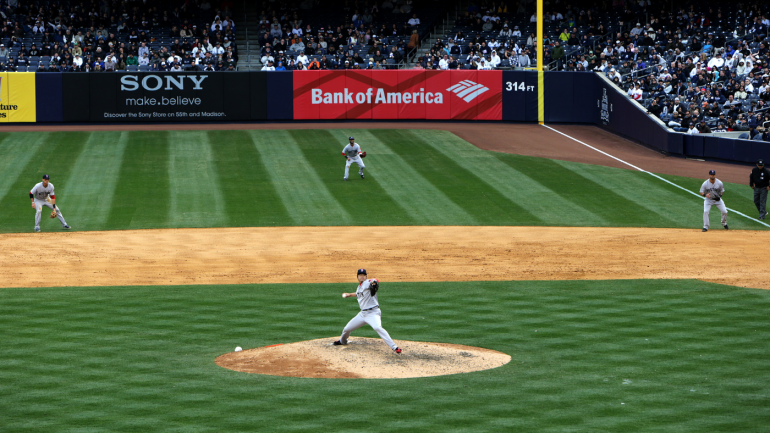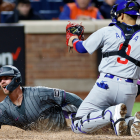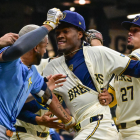
Major League Baseball has frequently used the minor leagues as testing ground for experimental playing rules. Thursday afternoon, MLB announced a new set of rules that will be implemented at various levels of the minors during the upcoming 2021 season, including a limit on defensive shifts. Here's the official announcement from MLB:
MLB will closely monitor and analyze the impact of each rule change throughout the 2021 season and report to Clubs on their effects for further analysis. Consistent with the preferences of our fans, the rule changes being tested are designed to increase action on the basepaths, create more balls in play, improve the pace and length of games, and reduce player injuries.
Now, let's review the rule changes for 2021 at the four different levels of minor-league play:
Triple-A: Larger bases
At the Triple-A level, the sizes of first, second and third base will be increased from 15-inch squares to 18-inch squares. MLB said that this move will be to reduce player injuries and collisions, adding that the "shorter distances between bases created by increased size to have a modest impact on the success rate of stolen base attempts and the frequency with which a batter-runner reaches base on ground balls and bunt attempts."
Double-A: Defensive positioning
The experimental rule at the Double-A level for 2021 is a limit on defensive shifts. The rule says that "the defensive team must have a minimum of four players on the infield, each of whom must have both feet completely in front of the outer boundary of the infield dirt." According to MLB, this restriction on defensive positioning is intended to increase the batting average on balls in play. Depending on the results of the experimental rule change, MLB may decide to then require two infielders to be positioned entirely on each side of second base in the second half of the Double-A season. Defensive shifts have been around a very long time, but in recent years, MLB shifts have gotten more and more bold.
High-A: 'Step Off' rule
This rule says that pitchers will be required to "disengage the rubber prior to throwing to any base, with the penalty of a balk in the event the pitcher fails to comply." MLB says that when a similar rule change was implemented at the independent Atlantic League in 2019, they saw a significant increase in stolen base attempts and an improved success rate after adoption of the rule.
Low-A: Robot umps, pickoff limits
At the Low-A levels, players will see a variety of rule changes. All Low-A leagues will have a rule where pitchers will be limited to a total of two "step offs" or "pickoffs" per plate appearance while there is at least one runner on base. MLB says that they leave room for adjustment, and could consider reducing the limitation to a single "step off" or "pickoff" per plate appearance with at least one runner on base based on the initial rules from the rule change.
At the Low-A Southeast level, the automated ball-strike system (ABS), also commonly referred to as the "robot umpire" will be implemented. The electronic strike zone was first tested in the independent Atlantic League before being expanded to the Arizona Fall League and now will be a part of select Low-A Southeast games to assist home plate umpires with calling balls and strikes. For an in-depth look at the technology, you can read more about the initial experiment with the Atlantic League here. With this new rule, MLB is showing that it's clearly interested in the continuation of experimenting with the electronic strike zone.
At the Low-A West level, there will be a pitch timer enforced, placing limits between delivery of pitches, inning breaks and pitching changes. This one, MLB says, is aimed to help reduce game length and improve the pace of play. In 2019, MLB rolled out pitch clock for spring training games, but the league has not experimented further at the big-league level.
While MLB wants a pitch clock to improve the pace of play, the MLBPA does not because the union is fundamentally opposed to adding a clock to baseball. MLB reportedly told the players' union it is willing to postpone implementing a 20-second pitch clock until after the current Collective Bargaining Agreement expires on Dec. 1, 2021.
"The game on the field is constantly evolving, and MLB must be thoughtful and intentional about progressing toward the very best version of baseball – a version that is true to its essence and has enough consistent action and athleticism on display to entertain fans of all ages," Theo Epstein, now a consultant to MLB, said in a statement Thursday. "These rules experiments will provide valuable insight into various ways to create a playing environment that encourages the most entertaining version of the game. What we learn in the Minor Leagues this year will be essential in helping all parties chart the right path forward for baseball."
There's going to be a delayed start to the 2021 season for most minor-league teams. The Double-A and Single-A seasons are scheduled to begin May 5. The Triple-A season will be delayed at least one month, and MLB will send reserve players to the alternate site (used during the abbreviated 2020 season) early in the regular season. The 2020 Minor League baseball season was canceled due to COVID-19. MLB will also continue its three-year partnership with the independent Atlantic League.
At the Major League level, the 2021 season, for now at least, plans to be the full, 162-game length. The key on-field rule changes include doubleheaders as two seven-inning games and each offense getting a runner on second to start every extra inning.






















